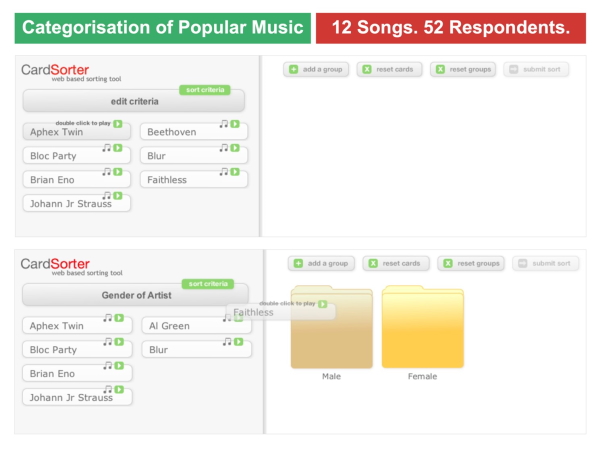Interaction design methods
In human-centred computing research, we are interested in methods for HCI research and Interaction Design. This has involved research into a technique called Card Sorting and how a relatively unpopularized variation of card sorting—‘repeated single-criterion sorting’—can be applied to the information architecture design of digital music services. Using an online card sorting tool that we developed, we found that although high levels of agreement were found for a small number of categories that people chose such as ‘genre’, ‘gender’ and ‘speed of song’, the remaining categories were individual to each respondent e.g. ‘songs that make me cry’. The results highlighted differences with current approaches to music categorization, as well as the potential for repeated single-criterion sorting to be used to design faceted navigation structures and form part of the user-centred design process. This work was presented at the BCH HCI Conference in 2021 and an extended version was chosen to be published in Interacting with Computers.

Above: Screenshot of our online card-sorting tool.
We have also been collaborating with Physiotherapists from Keele and the University of Liverpool, to investigate the design of a Diagnostic Decision Support System (DDSS) to reduce time to diagnosis in paediatric shoulder instability. We used a modified version of nominal group technique in focus groups, involving three clinical vignettes, to elicit physiotherapists’ decision-making processes and found that current methods of assessment are prone to bias and error and may lead to inconsistent or delayed provision of essential care. This work was published in the Journal of Physiotherapy and BMC Medical Informatics and Decision Making.
Key papers
- de Quincey, E. and Mitchell, J. (2022) Card Sorting for User Experience Design. Interacting with Computers, Volume 33, Issue 4, July 2021, Pages 442–457.
- de Quincey, E. & Mitchell, J. (2021) Using Card Sorting to Design Faceted Navigation Structures. 34th British HCI Conference (HCI2021)
- Philp, F., Faux-Nightingale, A., Woolley, S., de Quincey, E. and Pandyan, A. (2021) Evaluating the clinical decision making of physiotherapists in the assessment and management of paediatric shoulder instability. Physiotherapy. ISSN 0031-9406.
- Philp, F., Faux-Nightingale, A., Woolley, S., de Quincey, E. and Pandyan, A. (2021) Implications for the design of a Diagnostic Decision Support System (DDSS) to reduce time and cost to diagnosis in paediatric shoulder instability. BMC medical informatics and decision making 21 (1), 1-13.
Contact

Professor Ed de Quincey
Professor of Computer Science
- Colin Reeves, CR3
- +44 (0)1782 734090
- e.de.quincey@keele.ac.uk

